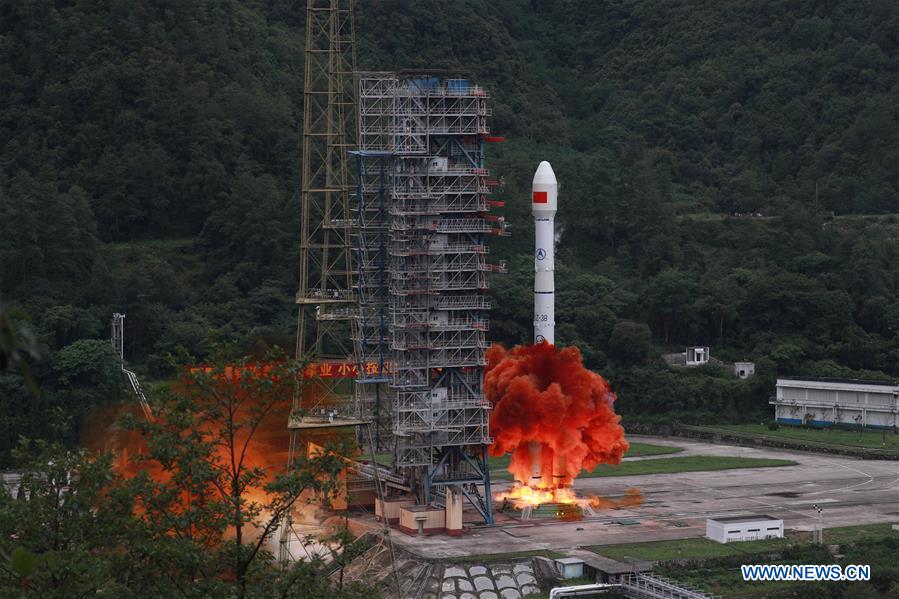


A carrier rocket carrying the last satellite of the BeiDou Navigation Satellite System (BDS) blasts off from the Xichang Satellite Launch Center in southwest China's Sichuan Province, June 23, 2020. China launched the last BDS satellite from the Xichang Satellite Launch Center at 9:43 a.m. on Tuesday (Beijing Time). (Photo by Hu Xujie/Xinhua)
The final satellite to complete the third-generation network of China's Beidou Navigation Satellite System was launched on Tuesday morning, marking a new milestone in the nation's space endeavors.
As the countdown ticked to zero — 9:43 am — at the Xichang Satellite Launch Center in Sichuan province, eight engines on the first stage and four boosters of a Long March 3B carrier rocket spat orange flame as they lifted the 19-story vehicle and satellite into cloudy skies.
The launch marked the completion of the in-orbit construction of Beidou, the country's largest space-based system and one of four global navigation networks, along with the United States' GPS, Russia's GLONASS and the European Union's Galileo.
Some medical workers from across Sichuan province who have fought against the COVID-19 were invited by space authorities to witness the landmark launch mission at the center.
The launch was broadcast live by China Central Television, the national broadcaster, becoming the first Beidou mission to go live on TV and also the first televised launch at the Xichang center in a decade.
After a period of in-orbit tests, the new satellite will start formal operations and work with other Beidou satellites, allowing users around the globe to access high-accuracy navigation, positioning and timing services according to the China Satellite Navigation Office.
The spacecraft, which was transported by rail to the Xichang center on April 4, was designed and made by the China Academy of Space Technology, a subsidiary of State-owned space conglomerate China Aerospace Science and Technology Corp. Based on the DFH-3B satellite platform, it is designed to work in orbit for at least 12 years.
The drive to establish a domestically developed satellite network for navigation and positioning was initiated by Chinese scientists in 1983, and the country began research and development of its own space-based navigation and positioning system in 1994, aiming to mitigate its reliance on foreign networks.
In 2000, China launched the first two Beidou satellites to establish an experimental system. In 2003 and 2007, another two experimental satellites were sent up to join the trial run.
Beidou's first mass-production satellite, also the first in its second-generation series, was launched in April 2007. The first two third-generation satellites were launched in November 2017.
The deployment of Beidou's space-based assets accelerated in the past two years, with 17 launches placing 28 satellites into orbit.
By now, 59 satellites, including the first four experimental ones, have been launched from Xichang on Long March 3Bs, some having since been put into retirement.
There are 30 third-generation Beidou satellites in three types of orbit — 24 in medium-Earth orbits, three in inclined geosynchronous satellite orbits and three in geostationary orbits.
There also are some second-generation Beidou satellites in operation offering regional services.
"Compared with the second-generation satellites, the third-generation models feature higher accuracy and stability, a clearer signal and more state-of-the-art technologies such as inter-satellite links, satellite-based augmentation and global emergency search capability," said Chen Zhonggui of the China Academy of Space Technology, chief designer of the third-generation satellite.
Chen said the new generation is 10 times stronger than the second generation in terms of overall service capability.
In addition to optimized navigation and positioning capabilities, the third-generation model allows a user to send 1,200 Chinese characters in a single message from places with poor conventional communication signals, while previous models could send only 120, he added.
As the most sophisticated space system, Beidou has not only tens of satellites but also a vast ground-based network that includes dozens of stations, more than 200 subsystems and over 30,000 sets of equipment.
More than 100,000 scientists, engineers and technicians from more than 300 domestic institutes and enterprises have been involved in Beidou's development and construction.
Beidou began providing positioning, navigation, timing and messaging services to civilian users in China and other parts of the Asia-Pacific region in December 2012. At the end of 2018, Beidou started to provide global services.
Next, China will continue improving the system's capabilities and services, the China Satellite Navigation Office said.

 Award-winning photos show poverty reduction achievements in NE China's Jilin province
Award-winning photos show poverty reduction achievements in NE China's Jilin province People dance to greet advent of New Year in Ameiqituo Town, Guizhou
People dance to greet advent of New Year in Ameiqituo Town, Guizhou Fire brigade in Shanghai holds group wedding
Fire brigade in Shanghai holds group wedding Tourists enjoy ice sculptures in Datan Town, north China
Tourists enjoy ice sculptures in Datan Town, north China Sunset scenery of Dayan Pagoda in Xi'an
Sunset scenery of Dayan Pagoda in Xi'an Tourists have fun at scenic spot in Nanlong Town, NW China
Tourists have fun at scenic spot in Nanlong Town, NW China Harbin attracts tourists by making best use of ice in winter
Harbin attracts tourists by making best use of ice in winter In pics: FIS Alpine Ski Women's World Cup Slalom
In pics: FIS Alpine Ski Women's World Cup Slalom Black-necked cranes rest at reservoir in Lhunzhub County, Lhasa
Black-necked cranes rest at reservoir in Lhunzhub County, Lhasa China's FAST telescope will be available to foreign scientists in April
China's FAST telescope will be available to foreign scientists in April